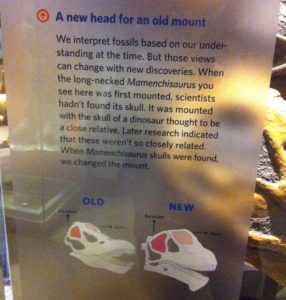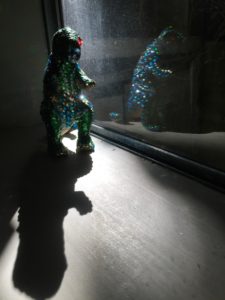Jaws gnashing, a massive, unwieldy grey-green head swings to and fro, shattering a grey-white fossilized skeleton, and promptly bellows a guttural roar! This symbolically cathartic scene confirms the climax Jurassic Park fans anxiously anticipated. The battle between Indominus Rex and the Tyrannosaurus Rex in the movie Jurassic World is a wet dream conferred. Dinosaurs awe children and adults. The Jurassic Park franchise epitomizes the eagerness of American capitalism to capitalize on imagination. The original Jurassic Park movie was named after the imagined park whose rise and fall the film chronicles. Around this park, ultimately an imagined idea, an ethos was created as a single film became a universe and the film became a franchise. Dinosaur fossils are often massive in comparison to animals currently living, a fact that inspires awe almost by definition. Awe translates to capital for the entertainment industry as well as archaeologists and museums. Fields of science are devoted to the study of fossils, in particular the study of dinosaur fossils. Whether through their size, foreign skeletal composition, or something bigger, dinosaur fossils stimulate the imagination. Similar Big Foot, the Loch Ness Monster, and other imagination inspiring/inspired creatures, ruminating on dinosaurs can lead to recognition that these creatures are far-fetched products of empowered imaginations albeit “grounded” in a vocabulary of real or real vs imaginary. After prolonged pondering, a question surfaces: how many layers of metaphor and imagination is Jurassic Park trafficking in? Cast in this light, the imagination that dinosaur fossils inspire is revealed as inherently problematic and problematically capitalistic.
In order to better appreciate the perspective that dinosaurs are complicated, problematic, and capitalist, this essay must be situated by defining terminology. The definition of dinosaur, according to the Apple Dictionary, begins: “a fossil reptile of the Mesozoic era, often reaching an enormous size.” The introduction of a generality, “often reaching an enormous size,” demonstrates that there is a dearth of specificity as regards dinosaurs. Also, the term “fossil reptile” feels opaque. The nearest paraphrase might be ‘extinct reptiles,’ which initially feels more transparent. The definition continues: “The dinosaurs are placed, according to their hip structure, in two distinctly related orders (see ORNITHISCHIAN and SAURISCHIAN). Some of them may have been warm-blooded, and their closest living relatives are the birds. Dinosaurs were all extinct by the end of the Cretaceous period (65 million years ago), a popular theory being that the extinctions were the result of the impact of a large meteorite.” Readers may note that the first sentence of the definition called dinosaurs fossil reptiles while this portion of the definition acknowledges that some dinosaurs “may have been warm-blooded.” It seems prudent, then, to look up “reptile,” a class of animals readers may believe to be “cold-blooded.” The definition, again from Apple Dictionary, confirms that a reptile is: “a cold-blooded vertebrate of a class that includes snakes, lizards and crocodiles, turtles and tortoises. They are distinguished by having a dry scaly skin, and typically laying soft-shelled eggs on land.” These two definitions are, thus, explicitly contradictory. There are other dictionaries that provide definitions that are differently oriented and which attempt to avoid the treacherous contradiction surrounding the cold or warm-bloodedness of dinosaurs, but upon deeper investigation, they ultimately yield the same contradictions. If a definition of ‘dinosaur’ cannot be discretely rendered, then does it have a definition? And if a word has no definition, is it a word, or merely gibberish? The slippery definition of dinosaur demonstrates that the term is nebulous at best and thus necessarily problematic. Illuminating the problematic nature of dinosaurs was as easy as looking the word up, but demonstrating that it is problematically capitalistic takes deeper research and engagement. Several years ago, visitors of the Natural History Museum of Los Angeles’ dinosaur exhibit may have seen the small placard pictured above that reads: “A new head for an old mount… We interpret fossils based on our understanding at the time. But those views can change with new discoveries. When the long-necked Mamenchisaurus you see here was first mounted, scientists hadn’t found its skull. It was mounted with the skull of a dinosaur thought to be a close relative. Later research indicated that these weren’t so closely related. When Mamenchisaurus skulls were found, we changed the mount.” Whether that placard is still present at the museum would be interesting to learn, but the prudent question that it poses is this: when scientists had the wrong skull placed on the ‘real skeleton,’ did they have a sign acknowledging that they were using creative license on the head of that skeleton? It seems preposterous to think that the thousands of visitors who saw the previously ‘complete’ skeleton were being lied to, but apparently they were, and it therefore seems doubtful that the choice was acknowledged at the time. This sign provides little solace for people walking around the world with the notion floating in their heads that they know, definitively, what a Mamenchisaurus skeleton looks like, when, in fact, they have the wrong head screwed on. Researchers, archeologists, scientists, and curators are paid to ensure that the items on display are ‘real’ or ‘true.’ Notions of veracity and objectivity bring to mind the opposition between the natural, or “hard,” sciences and the social, or, limply labeled, “soft,” sciences. Separation of the sciences is directly connected to capitalism when considering that the economics of the Natural History Museum, with its paying customers, donors, and budget, are predicated on a belief in objectivity. Museums of social science don’t exist as such. Instead, museums about human interaction, art, and culture are partitioned into various categories that limit the scope and often, in some way, discount their own ‘scientific methods.’ The social sciences are said to lack the normative, objective, simplicity of the hard sciences and they also lack the budget. Were it possible to calculate the GDP of natural sciences, they would likely perform much better than social sciences.
Illuminating the problematic nature of dinosaurs was as easy as looking the word up, but demonstrating that it is problematically capitalistic takes deeper research and engagement. Several years ago, visitors of the Natural History Museum of Los Angeles’ dinosaur exhibit may have seen the small placard pictured above that reads: “A new head for an old mount… We interpret fossils based on our understanding at the time. But those views can change with new discoveries. When the long-necked Mamenchisaurus you see here was first mounted, scientists hadn’t found its skull. It was mounted with the skull of a dinosaur thought to be a close relative. Later research indicated that these weren’t so closely related. When Mamenchisaurus skulls were found, we changed the mount.” Whether that placard is still present at the museum would be interesting to learn, but the prudent question that it poses is this: when scientists had the wrong skull placed on the ‘real skeleton,’ did they have a sign acknowledging that they were using creative license on the head of that skeleton? It seems preposterous to think that the thousands of visitors who saw the previously ‘complete’ skeleton were being lied to, but apparently they were, and it therefore seems doubtful that the choice was acknowledged at the time. This sign provides little solace for people walking around the world with the notion floating in their heads that they know, definitively, what a Mamenchisaurus skeleton looks like, when, in fact, they have the wrong head screwed on. Researchers, archeologists, scientists, and curators are paid to ensure that the items on display are ‘real’ or ‘true.’ Notions of veracity and objectivity bring to mind the opposition between the natural, or “hard,” sciences and the social, or, limply labeled, “soft,” sciences. Separation of the sciences is directly connected to capitalism when considering that the economics of the Natural History Museum, with its paying customers, donors, and budget, are predicated on a belief in objectivity. Museums of social science don’t exist as such. Instead, museums about human interaction, art, and culture are partitioned into various categories that limit the scope and often, in some way, discount their own ‘scientific methods.’ The social sciences are said to lack the normative, objective, simplicity of the hard sciences and they also lack the budget. Were it possible to calculate the GDP of natural sciences, they would likely perform much better than social sciences.
With that introduction to the capitalist element of the natural sciences, further development is necessary to demonstrate just how complicated that element is and whether dinosaurs are truly a focal node for this complicated capitalism. To that point, an essay titled “The Biggest Dinosaur in History may Never Have Existed” highlights the tenuous grasp natural sciences have on reality, thereby demonstrating one way in which the capitalism of science, reliant upon artifice to articulate reality, is complicated. The article details, among other things, the historical “Bone Wars” that occurred in the late 1800s between Edward Drinker Cope and Othniel Charles Marsh. In this article, there are numerous theories detailing how and why the Amphicoelias, the biggest dinosaur, may never have existed. One example discusses possible human error in recording notes about the size of the unearthed vertebrae supposedly belonging to the Amphicoelias. Also, there is acknowledgement that during the Bone Wars, “teams identified more than 100 new dinosaur species, though many of those species have since been lumped together or otherwise revised,” which shows the impact of pride, prestige, clout, and obtaining capital on the creation of new dinosaur species! Modern scientists would likely justify the refining of species by saying that progress has been made in the classification of dinosaurs, but the person reclassifying the dinosaurs is staking their own claim in the bone wars without even digging up any fossils. These changes and the Amphicoelias essay itself ignores the rewriting of textbooks and updating of editions that takes place while instances of species rejiggering occur (with new editions serving to boost the GDP of natural sciences). The article features a quote from Nathan Myhrvold, the polymath CEO of Intellectual Ventures and former CTO of Microsoft that states: “‘most current size estimates of dinosaurs are wrong.’” Understandings of dinosaurs are perpetually being revised and the 2016 understanding is much different from what people have historically understood dinosaurs to be. It seems obvious then that current scientific assertions will be recognized by future generations as outlandish, just as historical choices from the Bone Wars now seem absurd. The most alarming aspect of the article on the lack of evidence for Amphicoelias is the failure to acknowledge that these scientists study something passionately believed in while being centuries removed from the object. Recognition of that temporal distance is assumed but it needs acknowledging because readers are liable to forget that these scientists are unperturbed by the manipulated, man-made, and imaginary nature of the objects they study. The fanaticism of natural sciences is troubling. Dinosaurs, as currently conceptualized, are a product of human imaginations, imaginations that are simultaneously and contradictorily refined and untethered. The rational, objective scientific process is here wielded by minds unfettered by specificity, temporality, or acknowledgment of the half-blind conjectural groping taking place. Dinosaurs are a node because the term dinosaur is a simulacrum (in the cultural studies sense of the term). Natural sciences exist as the new Christianity of the capitalist west, expanding its own field, its own agenda, while alternative modes are systematically wiped out. Dinosaur study represents this capitalism’s ideal monopoly.
Scientists monopolize dinosaur knowledge, restricting access to creative thinking and curtailing imagination. There was a time when people didn’t have cell phones and didn’t live with presuppositions that humans know everything, didn’t know that there definitely isn’t, and probably never was, such thing as a dragon. Now, we are sure there were dinosaurs and we presume to know how they looked, ate, and behaved. And until we find new bones to the contrary, we have found all the dinosaurs, which also means there have never been dragons. Dragons are dead. Dinosaur bones are a finite resource and short of casually tripping on a vast archeological site, there is no shortcutting legitimate means of entry to the scientific field (the field of creating the name and lifestyle of the fossils you have seen). That monopolizing of an idea is profound and is true because dinosaur is gibberish, simply a cluster of ideas affixed to fossils that are imbued with nebulous ideas: ‘dinosaur.’ And only through proper channels can a person be ordained as ‘qualified’ to confirmed that bones dug up are indeed dinosaur bones. As a monopoly, dinosaur knowledge represents a complicated capitalism because American capitalism and capitalism generally has a complicated relationship with monopolies, sometimes asserting that they curtail freedom. Prices can be artificially manipulated when there is only one purveyor, leaving consumers bound to the whims of monopolists for consumption of a given product. Hard science is tethered to hard cash and natural scientists are the only people sanctified to deal in authentic, government-approved dinosaur imaginings. The complications inherent in becoming an expert in hard sciences are numerous and efforts risk disruption by the possibility that learning about real dinosaurs may be as easy as watching Jurassic World. After all, who’s to say that archaeologists currently taking strides in extracting live DNA from dinosaur fossils won’t complete the science-fiction-reality loop by engineering a new super-predator dinosaur and naming it Indominus Rex?
Bibliography:
Goldenberg, David. “The Biggest Dinosaur In History May Never Have Existed.” FiveThirtyEight. N.p., 11 Jan. 2016. Web. 04 Dec. 2016.









